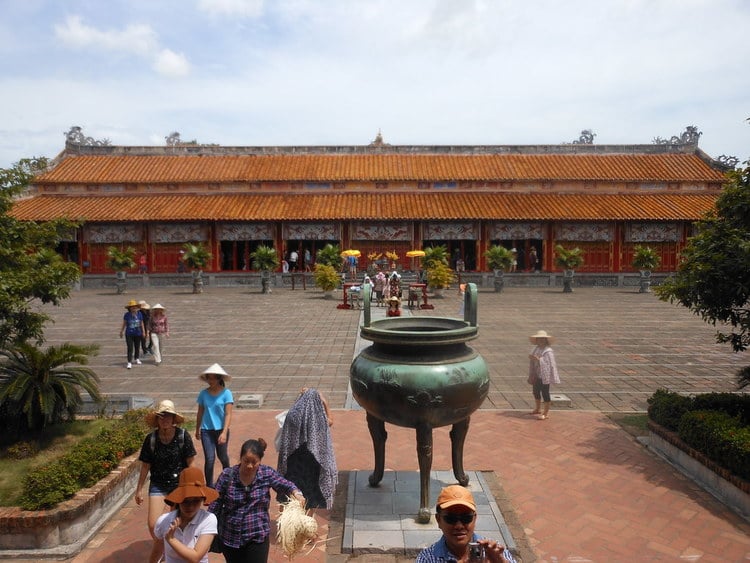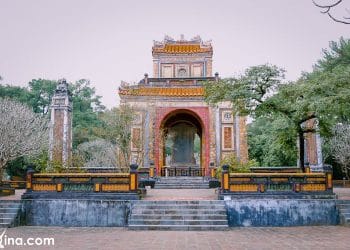The To Mieu (Thế Tổ Miếu) temple or The Mieu temple is located in the southwest of Imperial city inside Hue imperial citadel. Before, this place was Hoang Khao (Hung Mieu) temple where was used to worship Nguyen Phuc Con, Gia Long king’s father before it became the ancestor worship of the past emperor of the Nguyen Dynasty. The construction work was built by Minh Mang King in 1821 and completed after two years.
The Mieu temple which was constructed in the rectangle yard with the square area of more than 2 ha, accounts for a large part in Imperial city and Forbidden City. It was designed in style “trùng thiềm điệp ốc” (means two roofs in one floor) – Vietnamese traditional architectural style to create the large space for the temple. The square area of the floor is about 1.500 square meters.

The To Mieu Temple places a variety of personal items and portraits of its ten emperors. The frontal hall is divided into 11 compartments and two single lean-tos, while the main hall consists of nine compartments and two double lean-tos which are interconnected by meticulously carved wooden boards. The To Mieu temple has two roof floors that are tiled with “ngói ống lưu ly vàng” (a famous kind of tiles which are used to tile in temples, palaces), on the top, there are majestic detailed carvings of dragons.
Outside the temple, there is a large courtyard made with Bat Trang tiles. This ancestral temple is close to Hien Lam Pavilion, an ornate three-tiered pavilion built in 1822. It is considered the tallest building in the temple complex, placing artefacts such as meticulous carvings of dragons and a gold wine gourd inside its rooms. You can also watch nine dynastic urns situated between The Mieu Temple and Hiem Lam Pavilion. Each urn with the size of 2m tall and 2.600kg weight symbolises the power and stability of the Nguyen Dynasty. The central urn, the largest and most meticulous, is bestowed on the Dynasty founder, Gia Long King.
On the other side of a courtyard, there is the solemn To Mieu Temple where to house shrines to each of the emperors. And their photos are put on the top of each shrine. Also in the courtyard, two dragons are trapped in what is like red phone boxes. Between two temples are Nine Dynastic Urns (cửu đỉnh). Between 1835 and 1836, each Dynastic urn dedicated to one Nguyen sovereign.
On the north of the temple complex, a gate leads into a small walled area that places the Hung To Mieu Temple, a reconstruction of the 1804 original, built to worship Gia Long’s parents.

Today, besides the altar of Gia Long King and two queens housed in the middle, other Kings’ altars are arranged in the “tả chiêu hữu mục” principle (on the left are odd emperors’ shrines, on the right are even ones). According to the Nguyen Dynasty’ s customs and habits, emperors who were considered “deposed king” or “resigned king” would not be worshipped in The Mieu temple. Therefore, before 1958, Emperors Gia Long, Minh Mang, Thieu Tri, Dong Khanh, Tu Duc, Kien Phuc and Khai Dinh were worshipped in the temple. Until October 1958, altars of three patriotic kings Ham Nghi, Thanh Thai and Duy Tam who were assumed “resigned kings” were housed in Thai Mieu To temple. Today, the shrines of Bao Dai (Bảo Đại), Duc Duc (Dục Đức) and Hiep Hoa (Hiệp Hòa) still have not been placed in the temple.
Tourists should go on a tour to visit the place; it will be such a wonderful experience to learn more about the history of the Nguyen Dynasty and biography of Nguyen Kings through near a hundred year’s ruling. Notice that the daily opening hours are from 7:00 am- 5:00 pm, so you should arrange time suitably to join the trip to The To Mieu Temple without missing exciting and meaningful things in this architecture.
Written By M. Phuong
Proofread by Hang Pham















